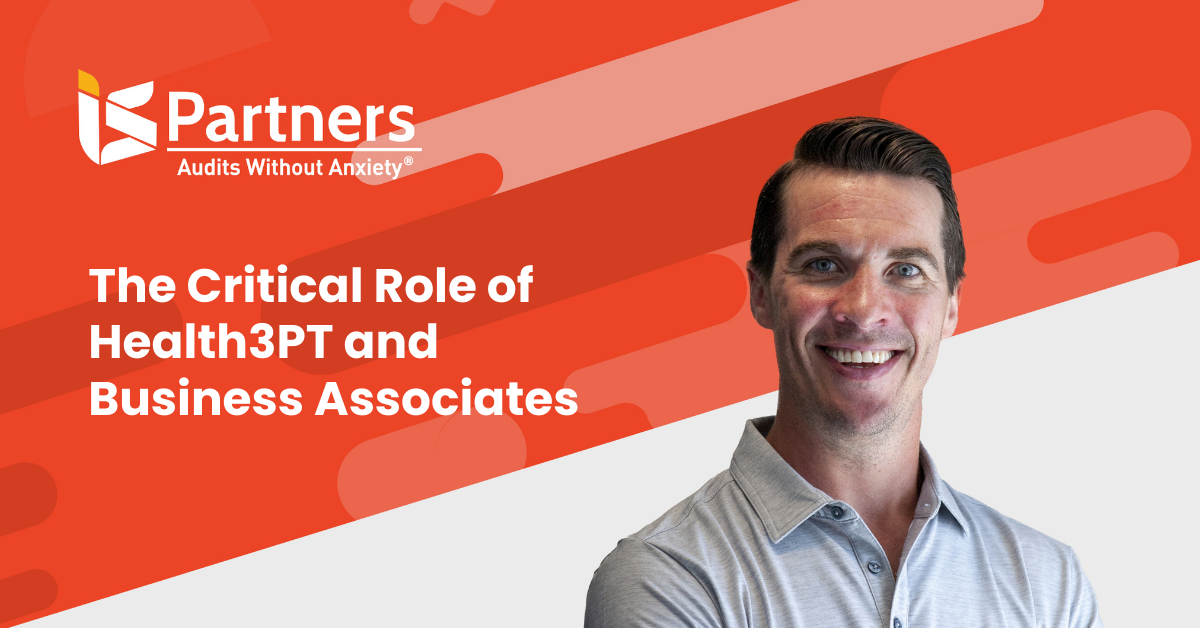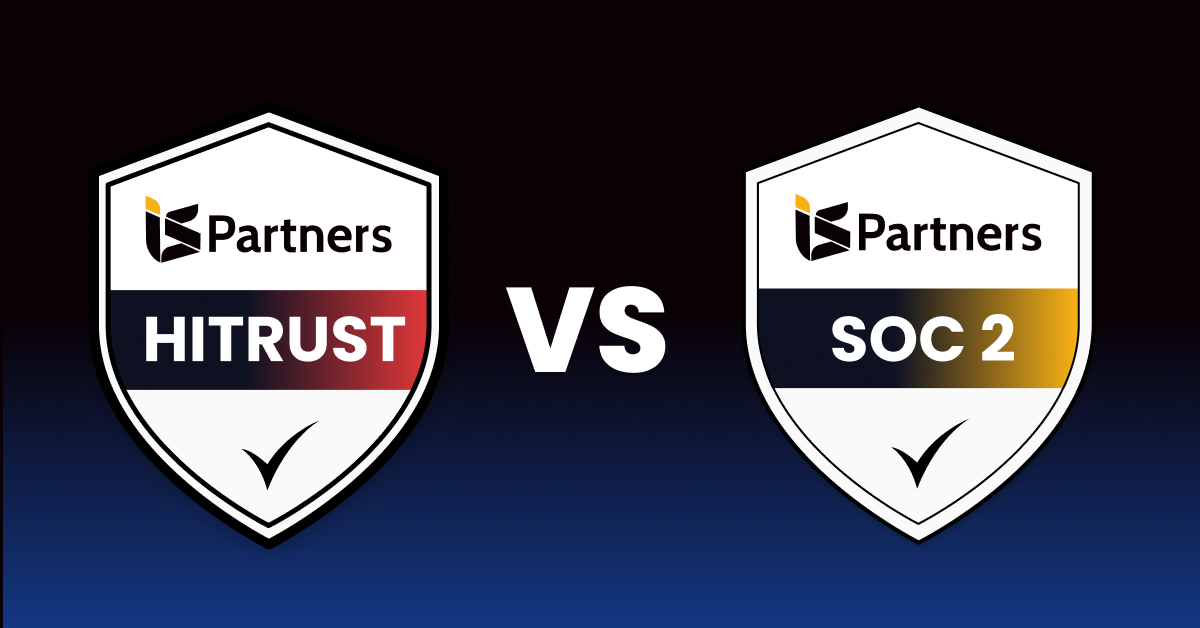Key Takeaways
1. HITRUST CSF is a certifiable framework that outlines key security controls for managing cybersecurity risks and threats across different industries.
2. In addition to addressing cybersecurity risks, HITRUST CSF maps out the foundation needed for compliance with other relevant frameworks, including ISO, NIST, GDPR, HIPAA, and PCI.
3. With over 20 years of experience in the compliance industry, I.S. Partners guides different organizations through hassle-free audits, including the HITRUST certification.
What Is the HITRUST CSF?
The HITRUST CSF®, originally called HITRUST Common Security Framework, is a structured system that helps support data protection and ensure security compliance. It’s a certifiable framework that provides organizations with a comprehensive, flexible, and efficient system for regulatory compliance and risk management.
The HITRUST® official website declares that the program was “born out of the belief that information security should be a core pillar of, rather than an obstacle to, the broad adoption of health information systems and exchanges.”
HITRUST, in collaboration with healthcare, business, financial, technology, and information security leaders, established HITRUST CSF, a risk management and compliance framework that can be used by organizations that create, access, store, or exchange personal health and financial information.
The HITRUST assessment framework was developed to bring harmony to the concept of open-system data sharing and information security. It helps healthcare industry organizations and other sectors handle sensitive information by providing a comprehensive and flexible mapping key to ensure data security.
What Companies Need HITRUST?
The HITRUST CSF caters to the healthcare industry, including healthcare organizations, stakeholders, and business associates. However, the framework’s recent revisions have made it applicable across different industries.
Although the common framework is not government-mandated, it is a highly trusted and recognized system that links to other critical healthcare security and privacy programs, such as HIPAA, ISO, SOC 2, and NIST.
Despite not being a mandatory regulation, the framework has become an industry standard for security. Kevin Patterson, I.S. Partners’ Healthcare Compliance expert, highlighted the importance of complying with HITRUST,
“The main selling point of the HITRUST CSF is that the framework is based upon a litany of other compliance frameworks, including ISO, NIST, HIPAA, and GDPR. The HITRUST CSF takes the most critical aspects of other common security and privacy frameworks. It combines them to provide a way for businesses to address various inherent risks. HITRUST certification is also a recognized and respected standard in the healthcare and broader industry, signifying a high commitment to security and privacy, potentially opening up new business opportunities and differentiating from competitors.”
Kevin Patterson, Healthcare Compliance Manager, I.S. Partners LLC
Other companies needing certification from HITRUST CSF include any technology companies providing solutions to the healthcare industry, such as electronic health records, patient portals, medical billing, and other health IT services, are often required by their customers to obtain HITRUST certification.

Advantages of Implementing the HITRUST Framework
Let’s take a closer look at the advantages of relying on the HITRUST framework for risk management assessment and security attestation.
Streamlines the Compliance Process
The HITRUST cybersecurity framework combines relevant information from existing security standards and compliance regulations defined by the federal and state governments as well as third-party and international bodies. These include:
- HIPAA. HIPAA compliance was enacted in 1996 “to publicize standards for the electronic exchange, privacy and security of health information.” Those covered by HIPAA include health plans, healthcare providers, healthcare clearinghouses, and business associates, wherein certain members can access healthcare records.
- HITECH. Enacted as part of the American Recovery and Reinvestment Act of 2009, HITECH was enacted to promote the adoption and meaningful regular use of health information technology capabilities for electronic healthcare information transmission.
- PCI. A third-party interest, the PCI has become intertwined with numerous industries. Working within HITRUST’s framework helps PCI issuers understand how vital their compliance is to ensuring patient and/or customer security and privacy.
- COBIT: Created in 1996 by ISACA, COBIT provides a good-practice system framework to promote the best practices in IT management and governance.
By unifying these regulations into a single, comprehensive set of prescriptive controls, HITRUST has built a powerful and clear framework. HITRUST offers solid guidance, not just for analysis and assessment but also for tracking and reporting compliance, as well as planning remediation strategies.
Addresses Cybersecurity Across Industries
Organizations across different industries – including the medical, life sciences, financial, technology sectors, and more – must ensure protection from similar types of cybersecurity threats. Using a single, overarching framework is a huge advantage for companies with interests, third-party vendors, and business interactions between different industries.
Increases Efficiency with Assessment & Attestation
HITRUST increases efficiency when it comes to regulatory compliance and risk management. It helps eliminate inefficiencies and overlaps created by trying to show compliance with multiple regulatory standards. CIOs and other information technology leaders can understand and follow the set of prescriptive controls and regulations laid out by the HITRUST framework for full compliance. In the end, organizations are able to save time and energy.
Allows Secure Sharing of Sensitive Data
In contrast to HIPAA – which is often considered “prohibitive” and regulation-heavy without allowances and means to share data – HITRUST framework controls enable entities to share data within a safe framework. The HITRUST’s comprehensive approach makes it easier for information technology managers to maintain high-quality standards while allowing the free flow of protected health information (PHI) and other sensitive information.
Enables Flexibility to Fit Organizational and System Structure
The HITRUST framework is intended to be used by companies that store, process, access, or transmit sensitive data – independent of their size, organizational structure, or IT infrastructure. Organizations are able to define the scope of HITRUST assessments in terms of the organization and systems, including facilities, devices, applications, and infrastructure components.
Because the HITRUST framework is both risk- and compliance-based, organizations can tailor the security control baselines based on various factors, including organization type, size, systems, and regulatory requirements. They can select the specific controls that are reasonable and appropriate for their organization or propose alternative controls to mitigate risk in accordance with HITRUST certification requirements.
Additionally, security controls can be scaled, adapting to any size and level of complexity in an organization.
Grows with the Organization and Security Regulations
HITRUST’s maturity model encourages continual improvement. As the individual organization works to improve data security over time, the HITRUST framework adapts to reflect its maturity level. Because the field of cybersecurity is constantly evolving, newer versions of the HITRUST CSF are periodically released to stay up to date with any changes in the standards from the various regulatory bodies.
What Are the HITRUST Compliance Requirements?
HITRUST CSF implements strict standards and systems through a set of security controls to become effective.
To prepare for a HITRUST certification process, ensure that you have the following programs and have completed these requirements.
- Implement HITRUST CSF Controls. Your company must know all controls, objectives, and specifications stipulated in the framework. These controls must be implemented based on the company’s risk profile, applicable regulatory factors, size, complexity, and type of assessment needed.
- Receive minimum maturity score. The certification process will evaluate the readiness of your system controls and must receive a maturity score of at least 3 for each domain from a scale of 1 to 5.
- Develop security policies and procedures. Implementation of the HITRUST controls must come with comprehensive documentation of the process. All established policies based on the framework must be properly recorded, including access control, risk management, incident plans, and data protection procedures.
- Undergo external audit. To achieve HITRUST certification, organizations must undergo a validated assessment by an authorized HITRUST external assessor. An assessor is a fair evaluator of your security protocols and compliance with HITRUST requirements. In addition, an experienced auditor can help you optimize your resources by directing you toward the necessary focus controls through a readiness assessment. The auditor will act as your connection to HITRUST to achieve certification.
- Continuous monitoring and evaluation. Once certified, organizations enter a two-year certification cycle. Under this cycle, the company will undergo an annual assessment to determine compliance with controls. All incidents and non-compliance must be properly addressed before the certification’s first year ends. A comprehensive assessment is required again at the end of the two-year cycle.
Compliance with HITRUST CSF involves meticulous planning and consistency from your organization. Hiring a competent external auditor who can guide you through the process can easily help you achieve these objectives.
I.S. Partners specializes in providing auditing services and commits to hassle-free compliance processes. One of I.S. Partners’ experts in healthcare compliance, Kevin Patterson, highlighted the key misconceptions when complying with HITRUST and specified critical steps to address these problems.
“Some businesses assume that becoming HITRUST CSF compliant is a simple or fast process. Achieving HITRUST CSF compliance is an extensive process involving detailed assessment and alignment with numerous security controls at maturity levels not typically required in other compliance frameworks. Assessors should conduct a thorough preliminary assessment and scoping process to help clients understand at a granular level the time and effort that will have to be allocated to complete a HITRUST assessment and become certified.
Another common misconception or challenge businesses face is assuming that informal processes and existing documentation are sufficient. HITRUST CSF places heavy emphasis on formal, comprehensive, and demonstrable documentation. Assessors must assist businesses, especially newer ones, in designing and implementing business processes that produce a formal and comprehensive audit trail. In addition, it is critical that assessors convey the importance of detailed policy and procedure documentation that is implemented, accurate to the company’s environment, and consistent with the associated requirements needed to become certified.”
Kevin Patterson, Healthcare Compliance Manager, I.S. Partners LLC
Our team of experts dedicated to HITRUST CSF compliance can help you evaluate your existing security system and build bridges to address gaps.
Contact us today and set up a meeting with our expert auditors!
HITRUST CSF – The Latest Version
HITRUST CSF version 11.3.0, the framework’s latest version, was released on April 16, 2024. The update adds 12 new standards to its original control frameworks.
The release of the new update illustrates the program’s commitment to providing an updated and adaptable framework toward evolving threats.
Some of the highlights of the new CSF v11.3.0 include the following:
- Authoritative sources, including FedRAMP, StateRAMP, and TX-RAMP, were added to ensure compliance with applicable security requirements.
- Integration of NIST SP 800-172 as support for high-risk organizations in their HITRUST r2 assessment. This step enhances protection for controlled unclassified information.
- Integration of CMMC Level 3 requirements for compliance with NIST standards.
- Included MITRE Adversarial Threat Landscape for Artificial-Intelligence Systems (MITRE Atlas) Mitigations to address security requirements crucial for safeguarding AI systems.
- Reduced redundant statements from requirements while decreasing the average r2 assessment size.
The new HITRUST CSF version strengthened integration networks with other stringent security frameworks, including NIST. In addition, the amendments to the framework ensure that compliant organizations are well-equipped against the emerging challenges of today’s cybersecurity threats.

The HITRUST Assessment Framework
Rather than designing broad-spectrum focal points, the architects of the HITRUST CSF created a series of highly specialized controls and domains. Separating these specific areas makes it easier to pinpoint problems so you can quickly and accurately reassess and correct your information security system.
This framework was designed to simplify the process of data security and information privacy assessment and attestation for covered entities and their associates with a standard methodology, requirements, and tools. It also helps organizations map controls for other security frameworks, including NIST, ISO/IEC 27001, HIPAA, PCI, and GDPR.
HITRUST Domains for Assessment
The HITRUST CSF uses 19 domains to make it easier for you and your team to isolate data protection concerns. In total, these domains include 135 security controls.
| HITRUST Domain Control | Description of the Controls Included | |
|---|---|---|
| 1 | Information Protection Program | Processes should be in place to ensure confidentiality, integrity, and availability of sensitive data. This includes the information security management system (ISMS). |
| 2 | Endpoint Protection | This refers to anti-virus/anti-malware configurations, firewalls, intrusion detection systems, software updates, patches, and more. It includes requirements common to laptops, workstations, storage (e.g., NAS) and servers. |
| 3 | Portable Media Security | This control domain includes mobile storage (e.g., USB drives, CD-ROMs, DVD-ROMs, backup tapes). |
| 4 | Mobile Device Security | This includes all aspects of configuration management (e.g., configuration item identification, configuration status accounting, change control, and configuration audit), as well as environments used for development and testing. |
| 5 | Wireless Security | This refers to all aspects of corporate and guest wireless networks but does not include protections for devices connected to other networks. |
| 6 | Configuration Management | This includes all aspects of perimeter and internal network security, such as network-based application-level firewalls and intrusion detection systems, DDOS protection, and IP reputation filtering. |
| 7 | Vulnerability Management | This includes vulnerability scanning and patching, antivirus/anti-malware and network/host-based penetration detection systems, and updates. |
| 8 | Network Protection | This covers all aspects of contingency, business continuity, and disaster recovery, like planning, implementation, and testing. |
| 9 | Transmission Protection | This includes web and network connections, such as those for VPN, email, and chat. |
| 10 | Password Management | This covers specific issues around the use of traditional passwords. |
| 11 | Access Control | This control includes all aspects of access control other than the use of traditional passwords. |
| 12 | Audit Logging and Monitoring | This refers to controls for audit logging and monitoring. |
| 13 | Education, Training, and Awareness | This domain control is for the awareness campaigns, as well as the initial and continual education and training provided for security personnel and standard users. |
| 14 | Third-Party Assurance | This refers to all aspects of managing risk linked to third parties, such as vendors and business associates. |
| 15 | Incident Management | These controls relate to incident monitoring and detection activities, incident response, and breach reporting. |
| 16 | Business Continuity and Disaster Recovery | This covers all aspects of contingency, business continuity, and disaster recovery, like planning, implementation, testing. |
| 17 | Risk Management | This includes risk assessment, risk analysis, and other operations connected to risk management. |
| 18 | Physical and Environmental Security | This domain includes physical and environmental security requirements for data centers and other facilities charged with storing, disposing of, and/or destroying sensitive information. |
| 19 | Data Protection and Privacy | The final domain addresses the organization’s compliance and privacy program and related controls. |
HITRUST Controls and Levels of Implementation
The HITRUST framework has defined 14 control categories for information security, with 49 control objectives and 156 control specifications. Each category covers different aspects of information security and risk management.
Based on an organization’s risk profile, they must select, focus, and implement applicable controls. The 14 major controls of HITRUST CSF include the following:
- Information Security Management Program
- Access Control
- Human Resources Security
- Risk Management
- Security Policy
- Organization of Information Security
- Compliance
- Asset Management
- Physical and Environmental Security
- Communications and Operations Management
- Information Systems Acquisition, Development, and Maintenance
- Information Security Incident Management
- Business Continuity Management
- Privacy Practices
These control categories are then divided into three separate levels of implementation. These levels are based on organizational and regulatory risk factors. Each of the three levels of implementation builds comprehensively on the level before it.
- Level 1 illustrates the minimum requirements for building a security system foundation based on risk factors, such as company size and geographic scope.
- Level 2 strengthens the previous level by adding additional criteria based on system risk factors. These factors include the type of sensitive data stored, mobile device usage, and third-party access.
- Level 3 includes all Levels 1 and 2 requirements, with more specified requirements based on regulatory factors.
Most organizations use a variety of levels of implementation according to their specific data protection needs. Preparing for HITRUST Assessments requires companies to understand these requirements to identify the applicable controls efficiently.
Enlist Expert Help for HITRUST Compliance
HITRUST CSF compliance can be viewed as a gateway to cybersecurity and other stringent security frameworks. Companies gain a lot by complying with HITRUST, but the process is never easy.
The HITRUST certification process requires comprehensive preparation and strict assessments to ensure compliance. In addition, your company will require guidance to place your focus on the right controls.
I.S. Partners, LLC. is an Approved HITRUST Assessor that assists clients with HITRUST readiness, creates and implements effective remediation strategies, and validates assessments for certification.
As approved assessors, our company remains up-to-date with the latest revisions and advancements in the framework. Your team will be in the hands of auditors who have been practicing this profession for over 20 years. I.S. Partners can become your trusted auditors and lead you through preparation until the end of the certification process.
Choose our one-stop-shop services and prepare your cybersecurity framework using the most efficient approach possible.
Contact the I.S. Partners team at 215-631-3452 for an initial consultation.




